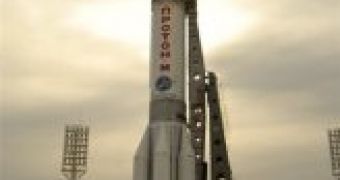The Russian-built Proton-M rocket launched from the Kazakhastan Baikonur cosmodrome on Saturday at 02:18 a.m. Moscow time, carrying a U.S. telecommunications satellite, but was unsuccessful in putting it in the planned orbit because of an engine failure. The satellite is owned by the SES Americom telecommunications provider, built by Lockheed Martin and has the ability to alter its telecommunication coverage by simply patching its software from the ground.
According to Khrunichev space center, "the engine of the Briz-M booster failed to work for the whole of the scheduled time and the satellite could not be taken to the planned orbit." It seems now that the booster engine is beyond repair, thus the AMC-14 satellite can only be put in a lower orbit around the Earth. 10 minutes after the liftoff, the rocket reached an altitude of about 35,000 kilometers, after which the Briz-M booster suffered a total failure.
Khrunichev officials said that the satellite has not been harmed in any way, just that it cannot be taken by the Proton-M rocket into the designated orbit. Alternatively, the spacecraft could make use of its own engines to position itself in the designated spot.
"The communications satellite has not been destroyed and could be used in a lower orbit or go into a higher orbit using its engines," said a spokesperson from the Roskosmos state space agency. Another Russian space agency official said that the "specialists can try and use the satellite's own engines to raise it into a higher orbit, but that would reduce the 15-year lifetime of the satellite. It is unlikely the satellite can be used".
The Baikonur cosmodrome located in Kazakhstan is a remnant of the Soviet space-era and is administered by Russia and benefits from a highly experienced team that can carry out up to a few dozens launches in the course of a year.

 14 DAY TRIAL //
14 DAY TRIAL //